The Importance of Supportive Ballet Shoes in Dance Practice
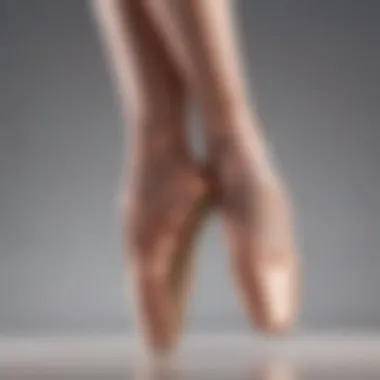
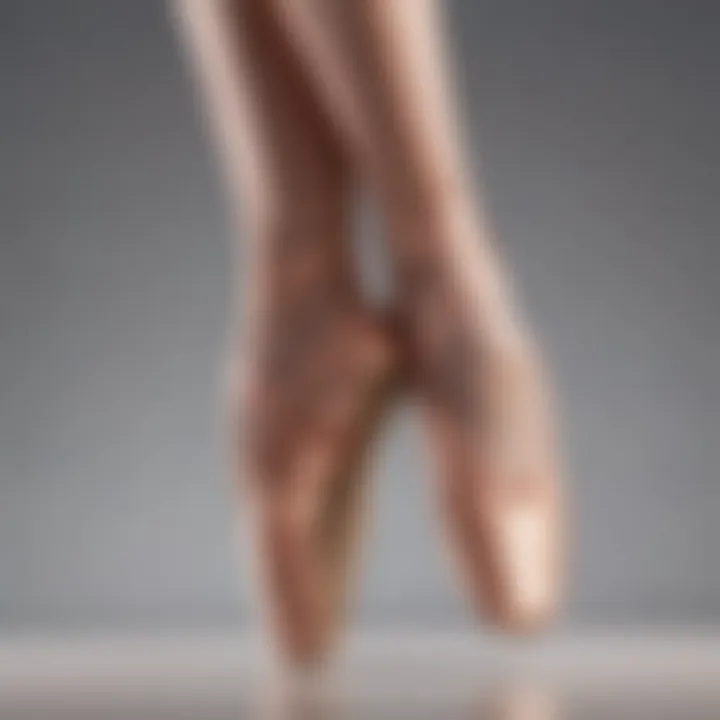
Intro
Ballet dancers require tools that enhance their performance and offer protection. Among these tools, supportive ballet shoes play a crucial role. The right pair of shoes not only facilitates movement but also helps in preventing injuries and ensuring comfort. Every dancer, from the beginner to the seasoned professional, understands the importance of selecting appropriate footwear. This article delves into the various factors to consider when choosing supportive ballet shoes.
Key Trends
Evolution of Ballet Shoe Styles
The ballet shoe market has seen significant changes in recent years. Dancers are now opting for designs that offer both functionality and style. Contemporary styles incorporate elements that enhance aesthetic appeal while maintaining essential support. Popular brands like Freed of London, Capezio, and Bloch focus on creating shoes that blend tradition with modern needs. This trend reflects the evolving nature of dance and how it adapts to the current cultural climate.
Materials and Technology
Innovations in materials have also influenced the choice of ballet shoes. Many dancers now prefer shoes made from breathable fabrics that provide better ventilation. Notable examples include canvas and leather, which cater to different preferences and performance requirements. Additionally, advances in construction techniques, like stitching and padding, result in shoes that provide improved support and durability.
Fit Considerations
The fit of ballet shoes is another area where trends have emerged. Dancers increasingly seek customized fitting options to cater to their unique foot shapes. Brands are starting to offer a wider range of sizes and widths, allowing greater accessibility for dancers of all backgrounds. Ensuring a proper fit not only enhances comfort but also promotes better performance during practice and performances.
"Choosing the right pair of ballet shoes is as crucial as mastering dance techniques, as it directly impacts performance quality and dancer health."
Performance Enhancement
Supportive ballet shoes significantly affect a dancer’s performance. The construction of the shoe should focus on providing optimal arch support and cushioning. This minimizes strain on the feet and legs, essential for executing intricate movements. Furthermore, a good pair of shoes enhances balance and stability, allowing dancers to pursue advanced techniques without the fear of injury.
Injury Prevention
Injuries in dance can be severe, and supportive shoes help mitigate this risk. Proper alignment and shock absorption are key factors that reduce the likelihood of common injuries such as strains or sprains. Dancers should look for shoes with sufficient ankle support and flexible soles to prevent twisting injuries while allowing natural foot movement.
Comfort During Practice
Comfort in dance practices cannot be overstated. As dancers often spend hours in their shoes, selecting a pair that feels right is vital. Features like padded insoles, adjustable straps, and breathable materials contribute to the overall comfort during rigorous sessions. Focusing on these elements ensures that dancers can dedicate themselves fully to perfecting their art.
Future Innovations
The future of supportive ballet shoes is promising. Emerging technologies are paving the way for designs that further prioritize dancer health. As the industry grows, so does the potential for customized solutions through 3D printing and other advanced manufacturing methods. Dancers can anticipate shoes tailored to their specific needs, enhancing both comfort and performance.
In summary, supportive ballet shoes are indispensable for dancers of all levels. They significantly impact performance, injury prevention, and comfort. As trends in design and materials evolve, the industry continues to adapt, ensuring that dancers can thrive in their craft.
Prelude to Supportive Ballet Shoes
Supportive ballet shoes play a critical role in a dancer's training and performance. The right footwear can influence not only how a dancer moves but also how they feel throughout practice. Having the appropriate support from ballet shoes helps to create a foundation for strength and stability. Dancers at any level of expertise should recognize the importance of selecting shoes designed for comfort and functionality.
Ballet developing requires a lot of physical effort. Dancers must execute precise movements and positions, which can put strain on their feet and bodies. This is where supportive ballet shoes come into play. Properly designed shoes absorb shock and provide necessary cushioning, minimizing the risk of injuries and enhancing posture.
In considering shoe selection, it is essential to understand the specific elements involved in ballet shoe design. Attributes such as the material used, the sole type, and cushioning can all impact performance. Understanding these aspects is invaluable for dancers, as it enables them to make informed decisions when purchasing shoes.
A good pair of supportive ballet shoes is not just a luxury; it's essential for maintaining foot health while pursuing dance.
Understanding Ballet Shoe Design
The design of ballet shoes centers on providing support and comfort. Dancers need shoes that move with them, allowing for a range of motions, while still offering stability. Key features of a supportive ballet shoe include:
- Material: Common materials are canvas, leather, and satin. Each has its own benefits, affecting flexibility and durability.
- Sole Type: Ballet shoes can be either full-sole or split-sole. Full-sole shoes provide extra support for beginners, while split-sole shoes can offer more freedom of movement for advanced dancers.
- Cushioning: Proper cushioning helps to absorb impact during jumps and leaps. This feature also aids in reducing stress on the feet.
When dancers understand the components of ballet shoe design, they can select options that best fit their unique needs and styles. This knowledge is important not only for comfort but also for optimizing their performance in various techniques.
The Role of Support in Dance
Support plays a crucial role in the practice of ballet. It provides dancers not only with physical stability but also enhances overall performance. Ballet requires a unique combination of strength and grace, making the right footwear essential. A supportive ballet shoe can help dancers execute intricate movements with ease while also minimizing the risk of injury.
Physical Demands of Ballet
The physical demands of ballet are significant. Dancers are often required to perform at high intensity, involving leaps, turns, and sustained balances. The strain placed on the feet and legs can be considerable. Without appropriate support, dancers risk overexertion, leading to fatigue and potential injuries.
Some of the common physical requirements include:
- Flexibility: Dancers must achieve a wide range of motion.
- Strength: Strong feet and legs are necessary to support the body's weight during performances.
- Balance: Dancers often balance on one leg, which necessitates firm support for the shoe.
Effective ballet shoes must cater to these demands. Well-constructed ballet shoes can offer specific support to the arch and heel, which aids in better weight distribution and reduces strain on muscles and tendons.
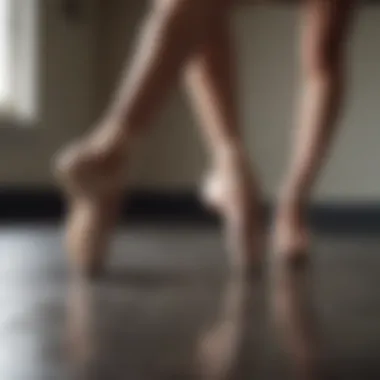
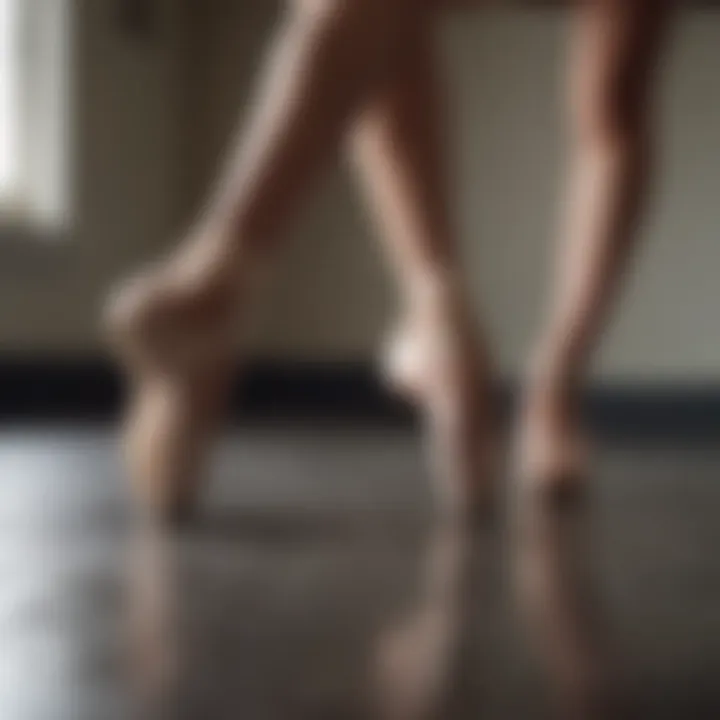
How Supportive Shoes Prevent Injuries
Supportive ballet shoes play a pivotal role in injury prevention. The absence of adequate cushioning or support can lead to repetitive stress injuries, which are common among dancers.
Some ways in which supportive shoes help include:
- Cushioning: This absorbs shock during jumps and landings, reducing impact on joints.
- Arch Support: Proper arch support helps to align the foot, preventing issues like plantar fasciitis.
- Stability: Shoes designed with a stable sole reduce ankle rolling, a common cause of sprains.
Dancers can experience long-term benefits from investing in high-quality supportive shoes. By alleviating pressure and stress on the foot, the risk of injuries diminishes significantly.
Types of Ballet Shoes
Understanding the different types of ballet shoes is essential for every dancer, whether novice or advanced. Each shoe type possesses unique characteristics that cater to specific needs and practices within the world of dance. Choosing the right ballet shoe impacts not only the dancer’s performance but also contributes to foot health. In this section, we will discuss the two primary styles: full-sole and split-sole shoes, and explore the various material options available.
Full-Sole vs. Split-Sole Shoes
The distinction between full-sole and split-sole shoes directly affects how a dancer feels and moves.
- Full-Sole Shoes: These shoes feature a single, continuous sole. This design provides a stable surface for beginners. The full sole helps in developing strength in the foot and allows for proper balance. Dancers often find this type to be ideal when first learning the foundational techniques of ballet. However, it may feel restrictive for those who require more flexibility as they advance in their practice.
- Split-Sole Shoes: These shoes have a divided sole, allowing greater flexibility and a more natural arch. This flexibility provides a wider range of motion, which is beneficial for advanced techniques and turns. Dancers who have mastered basic techniques often prefer split-sole shoes for their ability to enhance foot articulation and responsiveness.
Choosing between a full-sole and a split-sole shoe comes down to individual comfort, dance style, and the level of experience. It is crucial for dancers to try on different styles and see which one complements their technique best.
Canvas, Leather, and Satin Options
The material of ballet shoes also plays a significant role in performance and comfort. Each material has its benefits and drawbacks.
- Canvas Shoes: These are favored by many dancers for practice due to their breathability and lightweight properties. Canvas shoes are easy to clean and often less expensive. They provide adequate support and are generally more durable, making them ideal for frequent use.
- Leather Shoes: Leather offers a more classic look and tends to mold to the foot better over time. Dancers who prefer a snug fit and longevity may opt for leather shoes. Although they may be pricier, the durability and support provided are often viewed as worth the investment.
- Satin Shoes: Frequently used for performances, satin shoes have a beautiful appearance but may lack durability for regular practice. They typically offer a softer feel and enhance the aesthetics of a performance. Dancers should carefully consider when to use satin and ensure they have the proper shoe for practice to maintain foot health.
In summary, the choice of ballet shoes regarding both type and material should align with the dancer's needs, practice style, and comfort. Making informed decisions in this aspect is crucial in achieving both effective performance and long-term health benefits for the feet.
Choosing the Right Size and Fit
Selecting the right size and fit of ballet shoes is essential for both comfort and performance in dance practice. The relationship between shoe fit and a dancer's ability to execute movements cannot be overstated. Poorly fitted shoes can lead to discomfort, which in turn may affect concentration and performance quality. Additionally, they can contribute to the development of injuries over time. Therefore, understanding how to choose the right size and ensuring an appropriate fit is pivotal for every dancer, regardless of experience level.
Measuring Your Feet for the Perfect Fit
To achieve the perfect fit, one must start with accurately measuring the feet. This process involves measuring the length and width of both feet as well as taking into account the arch size. It’s important to note that many people have one foot slightly larger than the other; hence, it’s wise to fit based on the larger foot.
- Length: Stand on a piece of paper, tracing the outline of the foot. Measure the distance from the heel to the longest toe. This will give a reliable length measurement.
- Width: Use a cloth measuring tape to find the widest part of the foot. Compare this measurement against brand sizing charts, as sizing can differ.
- Arch: If possible, assess the arch height by observing the foot’s curve. A high arch may require specific features in a shoe that provide additional support.
Regularly measuring the feet is advisable since changes can occur over time due to factors like age or changes in physical activity.
Importance of Width and Arch Support
Beyond length, the width and arch support of ballet shoes are critical aspects to consider. A shoe that is too narrow can cause pinching and alignment issues, while a shoe that is too wide can lead to instability.
- Width: Choosing the correct width ensures that the foot is held securely in place. This contributes to balance and precision during performances. It is not uncommon for dancers to have different width requirements for each foot.
- Arch Support: Arch support plays a significant role in providing stability. Dancers with high arches may need shoes that offer enhanced support to avoid excessive strain on the foot. Conversely, individuals with low arches may require more cushioning.
In summary, understanding the nuances of fitting ballet shoes can significantly impact a dancer's experience. When shoes fit well, dancers can focus on their technique and artistry rather than discomfort.
"A proper fit allows dancers to maximize their potential and minimize injury risks."
This attention to detail in choosing the right size, width, and arch support is an investment in a dancer's overall performance and longevity in their craft.
Innovations in Supportive Ballet Shoe Technology
Innovations in supportive ballet shoe technology are critical for dancers of all levels. They enhance performance, promote comfort, and ensure the dancer's health. As ballet evolves, so does the technology behind the shoes. This section focuses on the most recent developments in shoe technology, including advances in materials and the impacts these changes have on a dancer's comfort and performance.
Advances in Materials Used
The materials used in ballet shoes have seen significant advancements over the last few years. Traditional leather and canvas are now being complemented with synthetic options that provide better durability, flexibility, and support. These materials not only improve the shoe's lifespan but also influence how the shoe molds to the foot.
- Synthetic Fabrics: Fabrics such as nylon blends are now common. They are lightweight and moisture-wicking, keeping feet dry during practice. This is crucial for avoiding blisters and other foot ailments.
- Memory Foam Padding: This innovation provides personalized comfort. As the foam conforms to the foot's shape, it offers enhanced arch support and shock absorption.
- High-Tech Mesh: Breathable mesh panels are incorporated in many designs. This increases airflow and maintains a cooler temperature inside the shoe, enhancing comfort during prolonged use.
Specialized companies are also focusing on designs that cater to individual needs. Dancers can now find shoes with dynamic support systems that adjust as they move, providing the necessary stabilization for complex routines. This allows artists to express themselves fully without the risk of injury.
Impact of Technology on Comfort and Performance
The impact of technology on comfort and performance cannot be overstated. Innovative design mechanics incorporate foot biomechanics, enabling a natural movement pattern.
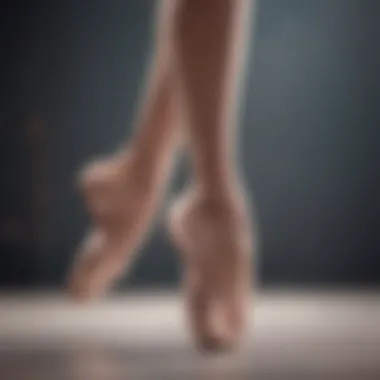
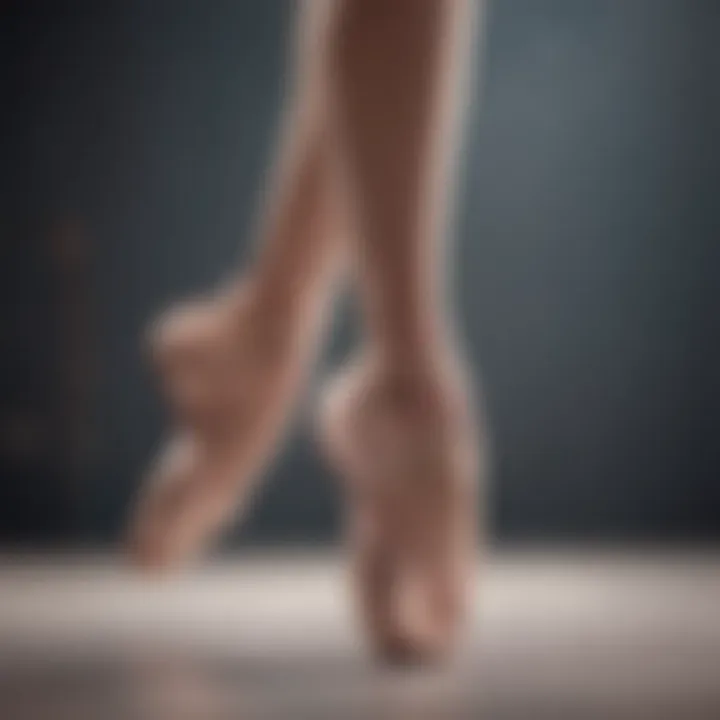
- Enhanced Arch Support: Many shoes now come equipped with advanced arch support systems. This not only provides better alignment of feet but also reduces the fatigue that dancers experience after long practice sessions.
- Lightweight Structures: The reduction of weight in materials directly affects performance. Lighter shoes contribute to agility, allowing dancers to execute jumps and turns with greater ease.
- Customizable Elements: Some brands are developing shoes with adjustable components. This allows for a personalized fit, ultimately leading to improved performance, as the dancer can focus on their technique rather than discomfort.
Moreover, these technological enhancements have a substantial effect on a dancer's mental approach to practice and performance. When dancers are comfortable, they can focus better on their craft, unencumbered by pain or discomfort.
"Investing in supportive ballet shoes equipped with the latest technology is not just a choice, but a commitment to one's art and health."
By understanding the advances in materials and the impacts of technology, dancers can make informed choices that align with their performance goals. These innovations truly enhance not just the quality of shoes, but also the quality of dance itself.
Foot Health and Maintenance
Foot health is paramount for dancers, as their feet endure constant strain and pressure during practice and performance. Neglecting proper care can lead to various issues that not only hinder performance but also affect overall well-being. Supportive ballet shoes are not just about style; they play a vital role in maintaining foot health by providing necessary support and reducing injury risk.
Preventing Common Foot Conditions
Dancers face unique foot conditions due to the demands of their art. Here are some common issues dancers may encounter:
- Plantar Fasciitis: This painful inflammation of the plantar fascia can arise from inadequate support. Wearing shoes with proper arch support can help alleviate strain on the fascia.
- Bunions: Misalignment of the big toe can lead to bunion formation. Choosing shoes that allow room for the toes can help prevent this condition.
- Achilles Tendonitis: Repetitive strain on the Achilles tendon can cause pain and swelling. Supportive ballet shoes that cushion the heel can significantly reduce the impact.
To prevent these common foot conditions, dancers should prioritize both the shoe fit and the quality of materials used. Regular foot exercises and stretches also play a role in keeping feet healthy.
Foot Care Tips for Dancers
Taking care of your feet involves a few basic yet effective practices:
- Daily Inspection: Check for any signs of redness, swelling, or blisters. Addressing issues early can prevent more serious conditions.
- Soaking and Moisturizing: Regularly soaking feet in warm water and applying moisturizer can maintain skin elasticity. This is particularly useful after long rehearsals.
- Footwear Rotation: Avoid wearing the same pair of shoes daily. Rotating shoes allows materials to regain their shape and support.
"Proper foot care is as critical as technique in ballet. Paying attention to your feet can enhance your overall performance and prevent future issues."
Ensuring good foot health not only enhances performance but also contributes to a more fulfilling dance experience. Regular maintenance of footwear can enhance a dancer's longevity in their craft and improve comfort during each rehearsal.
The Psychological Impact of Proper Footwear
Wearing proper ballet shoes has significant psychological effects that extend beyond comfort and performance. The right footwear is not merely a functional necessity; it also influences a dancer's mental state. This section focuses on how supportive ballet shoes can boost confidence and enhance mental preparedness during dance practice.
Confidence and Performance
When dancers wear supportive ballet shoes, their confidence can greatly increase. A well-fitted shoe provides a dancer with the assurance that their feet are protected and supported. This feeling allows them to focus on their movements rather than constant adjustments or discomfort. During performances, the stakes are notably high, and any distraction can impact a dancer's ability to deliver a compelling performance.
"The right shoes can make you feel like you can conquer the stage. Without that reassurance, anxiety can sabotage your performance."
Supportive shoes give dancers a sense of control. This perception translates directly into their movements. Whether executing complex choreography or performing graceful movements, shoes that fit well allow dancers to express themselves fully. Furthermore, confidence fosters resilience, enabling dancers to face challenges with a positive attitude, thereby enhancing their overall performance.
Mental Preparedness through Comfort
Comfort is an essential element that determines how prepared a dancer feels mentally. When feet hurt or feel restricted, it leads to mental distraction. Dancers might worry about potential injuries or fatigue rather than concentrating on their technique and execution.
Supportive ballet shoes alleviate these concerns by providing:
- Adequate arch support, which helps reduce fatigue.
- A snug fit that does not pinch or restrict movement.
- Materials that allow breathability and flexibility, ensuring comfort during long practice sessions.
These factors contribute to improved mental preparedness. Dancers who feel comfortable in their shoes are more likely to be focused, allowing for better learning and adaptation of new dance styles. They can delve into their creative processes instead of worrying about their feet.
Recommendations from Professional Dancers
Professional dancers provide invaluable insights when it comes to the selection of supportive ballet shoes. Their experiences shape the understanding of what works best in practice and performance scenarios. The recommendations tend to focus on several core elements: brand performance, comfort, style, and durability.
Many professional dancers emphasize that the right footwear can enhance movement, allowing for better expression and execution of choreography. A well-chosen pair of shoes helps minimize the risk of injuries and promotes foot health over time. When it comes to selection, it is essential for dancers to consider not only the aesthetic design of ballet shoes but more importantly, the functional aspects that contribute to their physical wellbeing.
Brand Preferences for Support and Style
Several brands have established themselves as leaders in the ballet footwear market. Among them, Bloch, Capezio, and Grishko are often favored by dancers for their balance of support and style.
- Bloch shoes are known for their innovative design and comfortable fit, making them a popular choice.
- Capezio offers a wide range of styles and materials, appealing to dancers who value variety and personal expression.
- Grishko is often chosen for its meticulous craftsmanship and durability, providing dancers with the long-term support they need.
Dancers often choose brands based on personal experience and feedback from peers. Comfort and usability are priorities for them. Proper fit can significantly affect performance, so many recommend trying different brands to find the right match.
Insights on Long-Term Use of Supportive Shoes
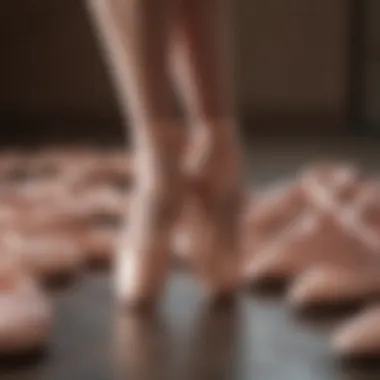
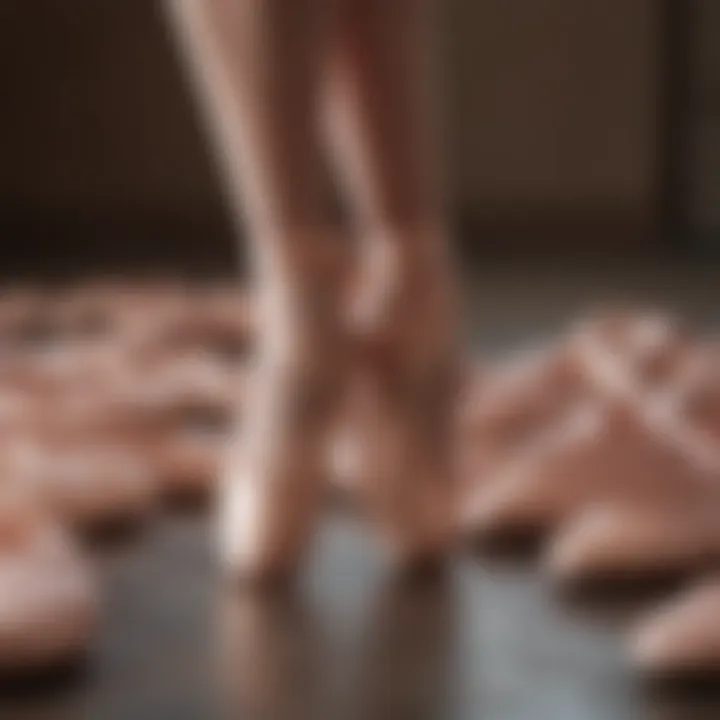
Long-term use of supportive ballet shoes requires careful attention to both the shoes and the dancer's foot health. Dancers noted that over time, supportive footwear can maintain its effectiveness if properly cared for. This includes several key practices:
- Regular cleaning to extend the life of materials.
- Rotating shoes to prevent wear and tear on a single pair.
- Replacing insoles as needed for consistent arch support.
Many dancers also mention noticing a significant reduction in foot strain when wearing properly designed supportive shoes. This reduction helps them focus on performance rather than discomfort. Insights gathered from ongoing use highlight the importance of selecting shoes that can withstand continuous use while still offering comfort and flexibility.
"The right ballet shoes are more than just a piece of equipment; they are an extension of the dancer's artistry."
By adhering to these recommendations and considerations, dancers can enhance not only their performance but also their overall enjoyment of dance.
Enhancing Performance through Shoe Selection
Selecting the right ballet shoes is crucial for dancers who aim to optimize their performance. Shoes designed with specific movement and support in mind enhance not only dance quality but also the dancer's overall experience. The right pair of shoes can significantly facilitate balance, agility, and grace during practice and performance.
Selecting Shoes for Specific Dance Styles
Different dance styles impose unique demands on shoes. For example, a dancer practicing contemporary ballet may benefit from flexible shoes that allow for greater foot movement, while a classical ballet dancer might require more structured footwear for support during pirouettes and jumps.
When choosing shoes, consider these factors:
- Arch Support: Certain styles, such as jazz or modern, might call for shoes with built-in arch support to accommodate various movements. In contrast, classical ballet shoes often prioritize flexibility but should still provide adequate support.
- Material: The choice of material affects how a shoe reacts under pressure. Leather, for instance, molds to the foot but may offer less stretch than canvas, which is more forgiving to fast-paced movement.
- Sole Type: The sole of the shoe can also vary by style, influencing grip and stability. For instance, split-sole shoes provide more freedom of movement for modern dance, whereas full-sole ballet shoes offer better support for traditional techniques.
Balancing Style and Functionality
Dancers often face the challenge of achieving a balance between visual appeal and the functional aspects of their footwear. While aesthetics are essential, compromising on support or comfort can lead to performance issues or even injuries.
To strike this balance, consider:
- Brand Reputation: Renowned brands such as Bloch and Capezio are known for their stylish yet functional designs that cater to a variety of dance styles.
- Fit and Comfort: A shoe can be visually stunning but uncomfortable. Prioritize fit over style, as it impacts overall performance.
- Durability: Look for shoes that can withstand rigorous practice. More durable materials often mean better performance longevity, translating to better efficiency and reductions in replacement costs.
"The right ballet shoes are not just about looks; they play a fundamental role in how effectively a dancer can perform and express themselves."
Sustainable Practices in Ballet Shoe Production
In recent years, there has been a growing awareness of sustainability across various industries, including dance. The production of ballet shoes is no exception. Sustainable practices in ballet shoe production not only address environmental concerns but also enhance the well-being of dancers for whom performance and comfort are key. The shift toward eco-conscious manufacturing reflects a collective responsibility to protect our planet while providing dancers with high-quality footwear.
Being involved in sustainable practices means prioritizing methods and materials that reduce environmental impact. This includes the use of eco-friendly production techniques, which can greatly minimize waste and pollution. As dancers increasingly seek products that align with their values, manufacturers find it necessary to embrace these practices.
Benefits of sustainable practices include reduced carbon footprints, lower toxicity levels in materials used, and improved biodegradability of the products. These aspects contribute to the health of the environment, while the dancers can enjoy footwear that is less harmful for them and the planet.
Eco-Friendly Materials in Shoe Manufacturing
The choice of materials in the production process is crucial. Traditional ballet shoes often utilize materials that may not be sustainable or biodegradable. However, eco-friendly options are becoming more accessible. Manufacturers are exploring alternatives like organic cotton, recycled polyester, and natural rubber. These materials not only lessen the ecological impact but can also provide better durability and comfort.
Using eco-friendly materials does not just help the environment, it also promotes a healthier product for the dancer. For instance, materials like organic cotton are less likely to contain harmful chemicals, which can reduce allergy and skin irritation risks. Moreover, some sustainable materials can offer better breathability and moisture-wicking properties, contributeing to the overall comfort during practice or performance.
"By choosing shoes made from eco-friendly materials, dancers can embrace their art while honoring the environment."
The Move Towards Sustainable Brands
The insight into the shift towards sustainable brands indicates a notable trend in the ballet community. Dancers, teachers, and schools are increasingly advocating for brands that prioritize environmental consciousness in their production processes. This demand is driving companies to reimagine their supply chains and product offerings.
Brands that commit to sustainable practices usually offer transparency about their manufacturing process. This can build trust with customers and encourage a more loyal customer base. Furthermore, the collaboration between dancers and sustainable brands can foster a powerful community where both sides champion environmental stewardship.
As more brands emerge, offering sustainable ballet shoes, it becomes imperative for the audience to evaluate these choices. Considersations such as brand reputation, material sourcing, and ethical labor practices should play a significant role in decision-making. Dancers may find joy in knowing their footwear choices are aligned with broader environmental goals.
Finale: The Essential Role of Supportive Ballet Shoes
Supportive ballet shoes are not just an accessory; they are fundamental to a dancer's journey. A proper pair of shoes can make a significant difference in a dancer's performance and overall well-being. Quality footwear specifically designed for ballet takes into account the unique movements and physical demands of this art form. This is essential for dancers of all levels, from beginners to professionals, giving them the confidence to express themselves entirely.
Summary of Key Points
A few points stand out regarding the importance of ballet shoes:
- Physical Support: Shoes with adequate support can prevent injuries by providing the right balance and cushioning. This is crucial for dancers who undergo rigorous training.
- Comfort and Fit: A well-fitted shoe allows for easier movements and enhances a dancer's ability to perform complex steps. Dancers must prioritize size, width, and arch support when selecting shoes.
- Material Choices: The type of materials used in shoes, whether canvas, leather or satin, plays a big role in performance and comfort.
- Psychological Factors: Comfortable shoes can also impact a dancer's mindset. Confidence in their footwear can boost performance and creative expression.
- Innovations: Tendencies toward sustainable practices and advancements in shoe technology are shaping the future of ballet footwear.
Future Innovations in Ballet Footwear
The future of ballet footwear looks promising with continuous innovations. Advances in materials are all about increasing comfort and reducing injury risk. For example, new foam technologies are creating increasingly supportive insoles that conform to the dancer's foot shape over time. This attentiveness to individual needs is what sets modern ballet shoes apart from older styles.
Moreover, sustainable practices are being embraced by several brands. Eco-friendly materials are making their way into production, catering to environmentally conscious consumers. These advancements not only cater to performance but also address the broader implications of production in the fashion industry. Ballet footwear is evolving and will likely continue to advance, offering new possibilities for dancers everywhere.
Dancers have always relied on their shoes. Today, they can rely on technology and more thoughtful design as well. This evolution in shoe-making will enhance performances and support dancers in achieving their fullest potential.



